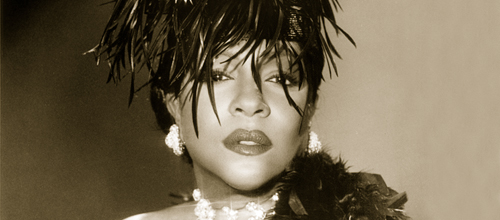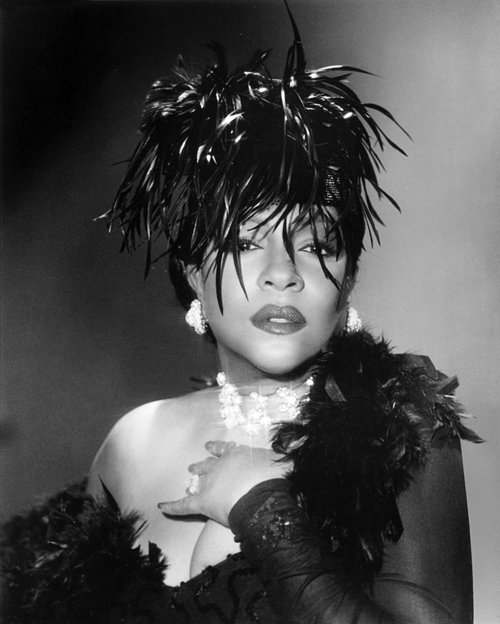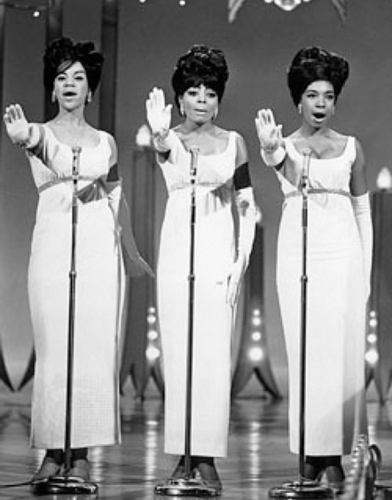
Stop! In the Name of Mary Wilson

One of the original Supremes talks about ‘Stormy Weather,’ gay marriage, and more
by Blase DiStefano
They were the Primettes before they were the Supremes, and Mary Wilson was one of the original members, along with Diana Ross, Florence Ballard, and Betty McGlown. When they became the Supremes in the early sixties, McGlown was replaced by Barbara Martin, who quit the group soon after when she became pregnant. Then came a number of hits, starting with “Where Did Our Love Go.” After a few years, Berry Gordy, head of Motown, changed the name of the group to Diana Ross and the Supremes. When Ross eventually left the Supremes, Wilson continued with the group until it was disbanded in the late seventies, becoming the longest-lasting member of the Supremes.
In 1986, Wilson published Dreamgirl: My Life as a Supreme; at the time it set records as “the most successful autobiography written by a musical figure.” Since then, she has not only published two follow-up books, but has also performed musical theater and a critically acclaimed jazz and blues cabaret act. A human rights activist, Wilson also contributes to artists’ rights political actions, and maintains her supreme legacy by organizing various museum displays of the Supremes’ famed costumes and performing the music of the Supremes all over the world.
To read the 1986 interview by Blase DiStefano with Mary Wilson, in which she talks about the other members of the Supremes—Diana Ross and Florence Ballard—click here.
Blase DiStefano: Hi, Mary. How are you doing?
I’m fine, thank you.
I want to start by telling you that I interviewed you in Dallas in 1986.
Oh!

And you were very nice to me—very approachable. Your book [Dreamgirl: My Life as a Supreme] had just come out. I was very nervous, but you made me feel comfortable.
Well, I’m glad to hear that. [Laughs]
I just wanted to tell you what that did for me.
Well, that’s awfully nice. Thank you.
A lot of has happened since then, hasn’t it?
Yeah, life, it goes on. It’s exciting.
Didn’t you go back to college?
Yes, I actually went to NYU, and I got my associate’s degree there. That was while I was actually living in New York.
How many children and grandchildren do you have?
I have three children and eight grandchildren. I have one adopted son in his fifties—so he contributed to the grandchildren.
[Laughs] When did you adopt?
It was before I had my children. I adopted him when he was 7 or 8. So he’s my eldest one.
That’s wonderful. Over the years haven’t you been involved in proposing a bill to ban impersonator groups?
Yes, I—and many other artists from the fifties and the sixties and seventies, actually—became part of this grassroots movement that proposed a bill, because many of us have become victims of this sort of thing that was going on and, to be honest, still is going on. In fact, my daughter just reminded me that there’s a group of Marvelettes imposters and drifters who are still working here in Vegas, even though the bill has been passed here.
The bill has been passed there, but they’re still doing it?
Yes. People have a lot of nerve. You can see online. You punch up “Supremes,” and some of these groups will come up as the Supremes. Just like the movie Dreamgirls. They used our history and our legacy as their own, as if they had done it. [Laughs] I have a couple of DJs who call me often to tell me about groups working in their area. As long as they can get away with it, of course they’ll do it. The “Wild West” days is what I call it. [Both laugh]
I know you were in Austin a few years ago to lobby for this law. Do you have any idea if it was passed in Texas?
Oh yeah, it was.
Oh good. Well, I say it’s good, but, hell, if they can get away with it anyway…
It has slowed itself. It has also educated people so that they are aware to ask questions when they go to these various venues. “Is this the real group?” Especially if it’s a group from that era. Governor Perry passed it. I was in Austin when he signed it. It was really cool.
Good. Well, I’m not a fan of Governor Perry, but at least he was part of that. [Both laugh]
There were lots of people that helped get that bill passed.
So it was a bipartisan thing.
Most definitely, most definitely. They were very, very helpful.
Also, over the years, you’ve been involved in the exhibit of the Supremes’ gowns. When I interviewed you, you had said you didn’t know where Florence’s gowns were. Did you ever find out where they were?
Not just Florence’s gowns, but all the other gowns that we all wore in the early days. The gowns that I have on exhibit are mostly from the later years.
With the help of some fans, I bought two or three sets off of the Internet on eBay. They would have been gone just like that [snaps her fingers].
I wanted to ask you more about the exhibit.
The exhibit is something I started because I had all the other gowns in storage. Because I moved so many times—I had them in New York, I had them in LA, I had them in Vegas—I said, “Gee, I’m just moving these things around.” We were talking with the Rock ’n’ Roll Hall of Fame, and they were saying they were going to start this museum. I said, “Well, I’ve got all the Supremes’ gowns.” Eventually they curated them for me.
At that point I knew I had to do something. They toured for several years; they went to England for three years.
Fans flew over from all over the world. And now we’ve brought them back here to the States and they’re beginning to tour here. They’ve been to two different museums so far. They’re in Houston…
What!?
Oh, no. They’re not coming to Houston.
I almost had a heart attack!
I’m sorry. [Both laugh] They’re basically starting to tour around America, and I’m very happy. Actually, some of them were at the LBJ Museum [in San Marcos]. The big thing now—and I’ll end with this on this note—is that they’re going to the Afro-American Museum in Philadelphia, which will probably be the biggest one we’ve had so far. It’s going to be kind of like our opening, even though it’s been to other ones here. They just took it over, and I believe it’s there until January. We’re working on that now. That’s going to be our biggie. We’re very happy about that.
I’m assuming you’re wearing different gowns in Stormy Weather.
Yes. The Lena Horne project is the brainchild of the author of the book, Stormy Weather. His name is James Gavin. I met him just by accident, and he said he had just put the book out. We started talking about how much I loved her, that I knew her, and that I had been thinking about her in the last month and was trying to get hold of her. Shortly after that, she passed. It was just the most amazing thing.
So, he said that he would love to have me be in Stormy Weather. He said he wanted his book to be alive, so he put together this little theatrical vignette where he reads excerpts from the book, and then has a couple of singers sing various numbers of hers. He asked me if I would like to be a part of it, and I’m like, “Sure!” I absolutely adored her. Also, I just started doing a jazz and standards show myself. So this guy fit right in to where I was going with my career.
He sent me the songs, and asked if I would be interested. I’m like, I love the idea! I put together my part—I sort of choreographed my part in the show with the songs, learned the songs. Then I decided, well, since I’m going to do the songs, I might try to wear gowns and hairstyles similar to what she did. I’m not impersonating her, by no means. I’m not trying to be her, but I’m invoking the period or the era of the whole thing. I think I have about eight changes in all, and hairstyles from the thirties that you roll back.
That sounds great. Is it a tour?
We do the same show in various cities. Last year we did about twelve different shows. One time we went to Australia. This year we went to Australia and were part of a festival. So it’s like a traveling Broadway show.
You’re coming to Houston early November, right?
Yes, and we have about six or seven shows we do in various cities.
You do stay busy, don’t you?
Yes, I do.
Did you get to meet Lena Horne?
Yes, on many, many occasions. In fact, I talk about that within the show. You know, how we met, and this and that.
Also, when I interviewed you in ’86, I couldn’t have imagined that I would ever see a black president in my lifetime. It boggles my mind. But what about you? Did it ever occur to you?
Well, being an African American, that was never a thought. I grew up in the era where my parents were still very afraid of “the white man,” and that was the way they would refer to it. Our parents were from the South. In the South, it was just a horrible way of living. It was all “yes ma’am” or “yes sir,” and if they caught you doing something that they didn’t like, you could be killed. I grew up in that environment. But they all thought that things would get better, and so they have.
And the unthinkable happened when Obama became president. It’s not so much Obama himself, but he represents what we all prayed for—that eventually we could be equal as human beings. That was a wonderful thing. And for America, too, because the time had come.
Thank God.
We have our problems now, but I think most presidents have encountered this kind of thing. They get in there and life is more difficult than anyone could think. It’s hard to do everything he would want to. But I think Obama does have great intentions. There’s just a lot going on here, and sometimes they say that it gets darker before it gets lighter. I think we’re kind of in that phase right now.
More of us have just got to think positive, positive, positive—and those kinds of things will help the planet move forward. For a lot of people, it’s more about me me me me me. That’s kind of where we are at, in terms of the universal movement.
Also, in 1986, I wouldn’t have imagined that gays would be able to get married, and now with Obama in favor of it, basically it’s around the corner.
Mm hmm. Mm hmm.
Do you perhaps have any gay friends who have tied the knot?
Oh, I have many. Many gay friends, and some of them have and some of them haven’t. Some have been together for like 40 years, so it’s in the air. [Both laugh]
I’ve never heard anybody say that about gay marriage, but that is such a perfect way to put it. It is in the air.
Yes, indeed. It is in the air. This is a time for change. This is it. We’re in a very historical time.
Now this is a question I often ask: if God said you have to switch sides for a day, who would you switch for? I interviewed Joy Behar recently, and she said she’d switch for Catherine Deneuve. And I said I would switch for her! [Both laugh]
You know, I’m one of those people—I love myself. I’d love to be myself and have everything I’ve always wanted. [Both laugh] Yeah, I just love myself. I’ve also been accused of that. [Both laugh harder] I’m happy with me, and that’s the honest-to-God truth.
What: Mary Wilson in Stormy Weather
When: November 9, 7:30 p.m.
Where: Miller Outdoor Theatre
6000 Herman Park Drive
Tickets/info: milleroutdoortheatre.com.
To read the 1986 interview by Blase DiStefano with Mary Wilson, in which she talks about the other members of the Supremes—Diana Ross and Florence Ballard—click here.










